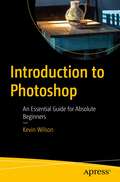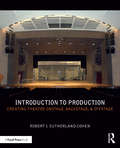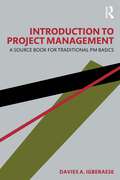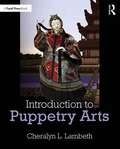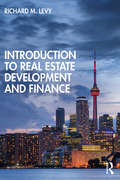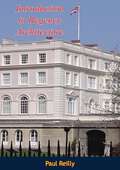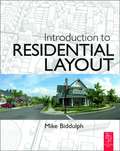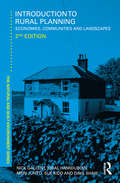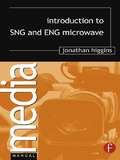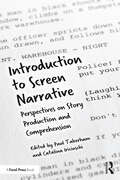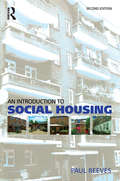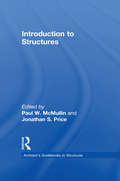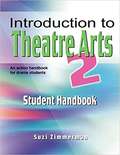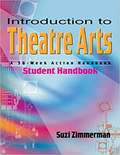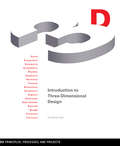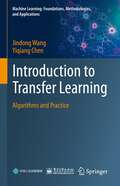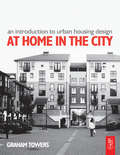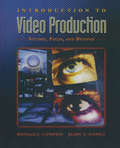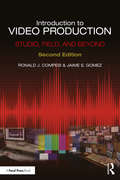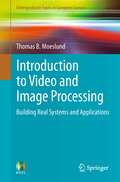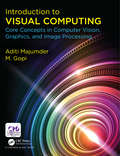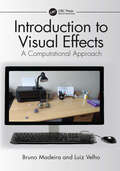- Table View
- List View
Introduction to Photoshop: An Essential Guide for Absolute Beginners
by Kevin WilsonThis full-color book is an essential guide to getting started with Adobe Photoshop. It's packed with tutorials, illustrations, and practical exercises to help you make sense of this complex and powerful software.You'll start with the basics of Photoshop, including an overview of its myriad tools and other options. Next, you will learn about some of the common tasks that can be performed in Photoshop, such as how to touch up images and basic applications in photography. You'll also be walked through how to leverage Photoshop for special and 3D effects. Each and every technique author Kevin Wilson presents is illustrated step-by-step using screenshots with concise, easy to follow text. Downloadable sample photoshop files and images are also provided, to help you work your way through the book.Whether you are a graphic design student, a photographer, or just a keen computer user, this book will provide you with a firm grasp of the underpinning foundations of Photoshop and equip you with the skills needed to unleash its full power.What You Will LearnUnderstand Photoshop's many toolsUse Photoshop to execute common image manipulation tasks Touch up photographs and other images in PhotoshopRemove lens distortion and make photos look more professionalWho This Book Is ForStudents, those interested in starting graphic design, and photographers looking to enhance, clean up and manipulate their photos. No experience with image-manipulation software is needed.
Introduction to Production: Creating Theatre Onstage, Backstage, & Offstage
by Robert I. Sutherland-CohenIntroduction to Production: Creating Theatre Onstage, Backstage, & Offstage defines the collaborative art of making theatre and the various job positions that go into realizing a production. Beginning with an overview of the art and industry of theatre, the book shows how theatre has evolved through history. The book then breaks down the nuts and bolts of the industry by looking at each professional role within it: from the topmost position of the producer down to the gopher, or production assistant. Each of these positions are defined along with their respective duties, rules, and resources that figure in obtaining these jobs. Each chapter offers exercises, links to videos and websites, review quizzes, and suggested readings to learn more about the creation and production of theatre.
Introduction to Project Management: A Source Book for Traditional PM Basics
by Davies A. IgberaeseThis book presents the fundamentals of project management in simple language and an easy-to-understand format. It is targeted principally at those who are learning or desiring to learn project management as well as those who are already taking project management as a course of study or as a profession. It covers all the basic aspects of project management including the core areas prescribed by the Project Management Institute (PMI) in the Project Management Body of Knowledge (PMBOK) sixth edition. Although the PMBOK Guide seventh edition has significantly shifted focus from a process based standard to a principle based standard, it does not invalidate nor replace the detailed knowledge base contained in the sixth edition, which substantially emphasizes project management processes and knowledge areas. This is particularly apt for the traditional approach to project delivery, which is predictive in nature and has the bulk of the planning done upfront. The sections of the book are arranged in order of Project Management Processes as they fall within the respective Project Management Knowledge Areas. Experienced project manager, Davies Igberaese, presents all the basic content of traditional project management in a straightforward practical sequence as a typical project manager would go about the processes of initiating, planning, executing, monitoring, and closing a project without losing sight of the iterative nature of project management. The inclusion of Project Management Templates gives students and other users of the book the confidence required to effectively understand the basics of managing a wide variety of projects across disciplines including construction, building, industrial engineering, petroleum engineering, software engineering, information technology, business administration, and event management. Introduction to Project Management: A Source Book for Traditional PM Basics can serve as a core textbook for academic courses in project management, for preparing for PMP and CAPM Certification exams, as an excellent resource for new project managers, as well as a handy reference book for project sponsors.
Introduction to Puppetry Arts
by Cheralyn LambethIntroduction to Puppetry Arts shares the history, cultures, and traditions surrounding the ancient performance art of puppetry, along with an overview of puppet construction and performance techniques used around the world. From its earliest beginnings in the ancient Middle East and Asia, through its representations in Medieval/Renaissance Europe, up until its modern-day appearances in theatre, television, and film, this book offers a thorough overview of how this fascinating art form originated and evolved. It also includes easy-to-follow instructions on how to create puppets for performance and display and an in-depth resource list and bibliography for further research and information. Written for students in puppetry arts and stagecraft courses, Introduction to Puppetry Arts offers a comprehensive look at this enduring craft and provides a starting point for creating a wide range of puppets, from marionettes and hand puppets to mascots and character costumes.
Introduction to Real Estate Development and Finance
by Richard M. LevyThis book provides readers with a basic understanding of the principles that underlie real estate development. A brief historical overview and an introduction to basic principles are followed by examples from practice. Case studies focus on how cities change and respond to the economic, technological, social, and political forces that shape urban development in North America. It is important to have a framework for understanding the risks and rewards in real estate investing. In measuring return, consideration must be given to both investment appreciation and the cash flow generated over the life of a project. In addition, metrics are presented that can be useful in assessing the financial feasibility of a real estate development proposal. This book also provides an overview of the forces of supply and demand that gauge the potential market for a new project. In determining the size of “residual demand”, estimates for population growth, family formation, and new development are important. All development projects fall under the auspices of one or several jurisdictions. Though every jurisdiction has different rules and procedures, basic knowledge of the planning process is critical to the success of all development projects regardless of location. Furthermore, all projects have a legal component. Basic issues of land ownership, property rights, property transfer, and land registration are reviewed, all of which need to be considered when a property is sold or purchased. This book also provides a primary on the design and construction process. In constructing a building, a team of experts is first required to design the architectural, structural, and heating, ventilation, and air conditioning (HVAC) systems for a building. An overview is provided of each building system: wood, concrete, and steel. Critical to a successful real estate development, project management principles for the processes of design, bidding, and construction are explored, with close attention given to budgeting, scheduling, and resource management. Essential reading for anyone involved in the development of our built environment, this is a must-read introduction for students and professionals in architecture, urban planning, engineering or real estate seeking an approachable and broad view of real estate development and finance.
Introduction to Regency Architecture
by Paul ReillyWith this book, author Paul Reilly had two ends in view. The first is to introduce the ever fewer examples of Regency buildings while they still exist. The second is to explain the historical role of Regency architecture, to show in what way it was a true descendant of the 18th century and in what way it broke new ground.
Introduction to Residential Layout
by Mike BiddulphIntroduction to Residential Layout is ideal for students and practitioners of urban design, planning, engineering, architecture and landscape seeking a comprehensive guide to the theory and practice of designing and laying out residential areas.Mike Biddulph provides a clear and coherent framework from which he offers comprehensive practical advice for designers of housing developments. Referring to a wealth of international examples, this is a richly illustrated, accessible resource covering the whole range of issues that should be considered byanyone engaging in the planning and design of a new residential scheme.A successful residential development must work on many levels – financial, social and environmental. This book includes analysis of commercial viability, the importance of place making, environmental sustainability and designing accessibility. Mike Biddulph details successful approaches to designing out crime and maximising permeability as part of an integrated approach to urban design.Highly illustrated throughout, this work will show you how to turn design aspirations and principles into practical design solutions. Written without preconceptions, Introduction to Residential Designhighlights the strengths and weaknesses of particular design solutions to encourage both depth of thought and creativity.Mike Biddulph is Senior Lecturer in Urban Design at Cardiff University
Introduction to Rural Planning: Economies, Communities and Landscapes
by Nick Gallent Iqbal Hamiduddin Meri Juntti Sue Kidd Dave ShawIntroduction to Rural Planning: Economies, Communities and Landscapes provides a critical analysis of the key challenges facing rural places and the ways that public policy and community action shape rural spaces.? The second edition provides an examination of the composite nature of ‘rural planning’, which combines land-use and spatial planning elements with community action, countryside management and the projects and programmes of national and supra-national agencies and organisations. It also offers a broad analysis of entrepreneurial social action as a shaper of rural outcomes, with particular coverage of the localism agenda and Neighbourhood Planning in England. With a focus on accessibility and rural transport provision, this book examines the governance arrangements needed to deliver integrated solutions spanning urban and rural places. Through an examination of the ecosystem approach to environmental planning, it links the procurement of ecosystem services to the global challenges of habitat degradation and loss, climate change and resource scarcity and management. A valuable resource for students of planning, rural development and rural geography, Introduction to Rural Planning aims to make sense of current rural challenges and planning approaches, evaluating the currency of the ‘rural’ label in the context of global urbanisation, arguing that rural spaces are relational spaces characterised by critical production and consumption tensions.?
Introduction to SNG and ENG Microwave
by Jonathan HigginsAn excellent primer on the subject, this book gives beginning professionals in satellite newsgathering an introduction to the technologies and processes involved. It will also suit journalists, editors and producers needing to understand this important element of the newsgathering chain. Written for the complete beginner, the book shows how typical transmission chains work and their communication with the studio. It also offers a brief introduction to analogue and digital theory before going onto to explain Electronic Newsgathering (ENG) systems: from basic principles: transmission and reception chains, frequencies used and why, through to audio channel, subcarriers and digital modulation, as well as applications: radio cameras, window links, infra-red & laser links.A brief chapter on satellite theory gives an overview of satellite communication and orbits, basic satellite communication theory, transportables (`flyaways') and trucks, as well as analogue vs digital issues, digital compression and MPEG. Systems regulations and operations are also introduced as well as safety and logistics issues.If you're looking for a quick and easy introduction to the subject, this book will act as an essential on the job reference guide.
Introduction to Screen Narrative: Perspectives on Story Production and Comprehension
by Paul Taberham Catalina IricinschiBringing together the expertise of world-leading screenwriters and scholars, this book offers a comprehensive overview of how screen narratives work. Exploring a variety of mediums including feature films, television, animation, and video games, the volume provides a contextual overview of the form and applies this to the practice of screenwriting. Featuring over 20 contributions, the volume surveys the art of screen narrative, and allows students and screenwriters to draw on crucial insights to further improve their screenwriting craft. Editors Paul Taberham and Catalina Iricinschi have curated a volume that spans a range of disciplines including screenwriting, film theory, philosophy and psychology with experience and expertise in storytelling, modern blockbusters, puzzle films and art cinema. Screenwriters interviewed include: Josh Weinstein (The Simpsons, Gravity Falls), David Greenberg (Stomping Ground, Used to Love Her), Evan Skolnick and Ioana Uricaru. Ideal for students of Screenwriting and Screen Narrative as well as aspiring screenwriters wanting to provide theoretical context to their craft.
Introduction to Show Networking
by John HuntingtonIntroduction to Show Networking covers the basics of how Ethernet networks provide a platform for entertainment control and audio/video media distribution for concerts, theatre productions, corporate and special events, cruise ship revues, wrestling shows, houses of worship, museum presentations, fountain spectaculars-any kind of show presented live for an audience. <p><p>The book's bottom-up approach was designed with show technicians in mind, starting with the basics and then moving up through cables, network switches, and layering, and on through Ethernet, and network components like TCP, UDP, IP and subnet masks, all with a practical focus. More advanced concepts are introduced, including broadcast storms and VLANs, along with show networking best practices. Closing out the book is a network design process demonstrated through practical, real-world examples for lighting, sound, video, scenic automation, and show control networks. An appendix covering binary and hexadecimal numbers is also included. <p><p>This easy-reading book draws from Huntington's Show Networks and Control Systems, the industry standard since 1994, but is completely re-focused, reorganized, and updated.
Introduction to Social Housing
by Paul ReevesThe provision and management of social housing for those who are unable to access the housing market is essential to the maintenance of the fabric of society. The social housing industry is vast and still growing. There are very few countries in the world where some form of subsidised housing does not exist, and the total number of social homes is likely to grow worldwide, as are the challenges of the sector.Paul Reeves takes a people-centred approach to the subject, describing the themes that have run through provision of social housing from the first philanthropic industrialists in the 19th Century though to the increasingly complex mixture of ownerships and tenures in the present day. The management of housing forms a key part of the book, with an emphasis on the practical aspects of tenant participation and multi-agency working.The book is ideal for students of housing and social policy, and for housing professionals aiming to obtain qualifications and wanting a broad understanding of the social housing sector.
Introduction to Structures (Architect's Guidebooks to Structures #1)
by Paul W. McMullin Jonathan S. PriceIntroduction to Structures - the lead book in the Architect’s Guidebook to Structures series - presents structures in simple, accessible fashion through beautiful illustrations, worked examples, and from the perspective of practicing professionals with a combined experience of over 75 years. It introduces the student to, and reminds the practitioner of, fundamental structural design principles. Beginning by introducing structural forms in nature and history, the process of design, and selecting structural systems and materials, the book then moves onto statics, mechanics of materials, and structural analysis. The final chapter provides guidance on preliminary structural design, complete with decision criteria and design tables. Edited by experienced professional structural engineers, with vital contributions from practicing architects, Introduction to Structures is fully illustrated, contains clear step by step examples and preliminary design guidance. Designed as a key textbook for introductory structures courses, it is also an indispensable reference for practicing architects.
Introduction to Theatre Arts 2: An Action Handbook for Drama Students
by Suzi ZimmermanThose who have already discovered the ease of teaching Theatre Arts with Suzi Zimmerman's first textbook will be thrilled to learn she has come out with this sequel! <p><p> This action handbook takes all the outstanding components you loved in the first book and applies it to seven new sections: 1. Theatre for Life s Lessons, 2. Movement Theatre for the Eyes, 3. Voice Theatre for the Ears, 4. Skill-Building Activities Theatre Projects, Mini-Units and Self-Guided Lessons, 5. Understanding and Writing Scripts, 6. Theatre Behind the Scenes, and 7. Production 101. Theory combined with hands-on is the style of every chapter. This series has been classroom-tested to fit the budgetary considerations of all schools.
Introduction to Theatre Arts: A 36-Week Action Handbook
by Suzi ZimmermanAt last! A student-friendly, teacher-friendly workbook with study units for a full year of classroom drama activities. <p><p> The entire spectrum of theatre is covered in ten sections: 1. Getting Started, 2. Evaluation, 3. Scene Work, 4. Acting, 5. Characterization, 6. Publicity and Other Production Business, 7. Play Production, 8. Theatre History, 9. Games and Improvisation, 10. Planning for the Future. All units are complete with detailed instructions, examples, working forms, and photo illustrations. Students will learn all the basics of theatre history, play production, performing, and finding a career in theatre. This instructional program is classroom-tested and designed to fit the budgetary considerations of schools.
Introduction to Three-Dimensional Design: Principles, Processes, and Projects (Design Brief Ser.)
by Kimberly ElamIntroduction to Three-Dimensional Design is the first book to teach graphic design students the fundamentals of three-dimensional design through hands-on drawing and model projects. The book combines key concepts with carefully crafted exercises so students can apply three-dimensional design principles in practice. From initial sketches through experimental prototypes to the final model solutions, students will develop a deeper understanding of the often complex elements and principles of three-dimensional design.
Introduction to Transfer Learning: Algorithms and Practice (Machine Learning: Foundations, Methodologies, and Applications)
by Jindong Wang Yiqiang ChenTransfer learning is one of the most important technologies in the era of artificial intelligence and deep learning. It seeks to leverage existing knowledge by transferring it to another, new domain. Over the years, a number of relevant topics have attracted the interest of the research and application community: transfer learning, pre-training and fine-tuning, domain adaptation, domain generalization, and meta-learning. This book offers a comprehensive tutorial on an overview of transfer learning, introducing new researchers in this area to both classic and more recent algorithms. Most importantly, it takes a “student’s” perspective to introduce all the concepts, theories, algorithms, and applications, allowing readers to quickly and easily enter this area. Accompanying the book, detailed code implementations are provided to better illustrate the core ideas of several important algorithms, presenting good examples for practice.
Introduction to Urban Housing Design: At Home In The City
by Graham TowersThis clear and concise guide is the ideal introduction to contemporary housing design for students and professionals of architecture, urban design and planning. With the increasing commitment to sustainable design and with an ever-increasing demand for houses in urban areas, housing design has taken on a new and crucial role in urban planning. This guide introduces the reader to the key aspects of housing design, and outlines the discussion about form and planning of urban housing. Using chapter summaries and with many illustrations, it presents contemporary concerns such as energy efficient design and high density development in a clear and accessible way. It looks at practical design solutions to real urban problems and includes advice on reclamation and re-use of buildings. The guidance it presents is universally relevant. Part two of the book features current case studies that illustrate the best in high density, sustainable housing design providing the reader with design information, and design inspiration, for their own projects.
Introduction to Video Production: Studio, Field, and Beyond
by Ronald Compesi Jaime GomezWritten in a clear, non-technical manner, Introduction to Video Production focuses on the fundamental principles of video production and the technologies used in production. This book discusses video aesthetics, technologies, and production practice in a clear and concise manner. It also emphasizes the importance of teamwork and planning in the production process. Chapters are clearly organized and heavily illustrated, with key terms identified in boldface. With Introduction to Video Production, readers will learn not only how the technology works, but how to work with the technology and with each other.
Introduction to Video Production: Studio, Field, and Beyond
by Ronald J. Compesi Jaime S. GomezWritten in a clear, non-technical manner, Introduction to Video Production focuses on the fundamental principles and aesthetics of video production and the technologies used in both studio and field environments. Ronald J. Compesi and Jaime S. Gomez cover each aspect of the process step by step, from preproduction to lighting, sound, directing, editing, graphics, and distribution. Taking into account the changes in workflow and production planning and distribution brought on by the advent of digital media, this second edition has been updated throughout to account for the increasing popularity of DSLR cameras, online distribution, the rise of portable cameras and mobile video, and much more. Key features include: a thorough overview of video production in studio and field environments without being overly technical, allowing students to get the "big picture" of production; coverage of new digital production, recording, and editing technologies; over 300 photos and line art illustrating aesthetic elements, technical issues, and production planning; key words identified in boldface throughout the text and reinforced in a comprehensive glossary of terms.
Introduction to Video and Image Processing
by Thomas B. MoeslundThis textbook presents the fundamental concepts and methods for understanding and working with images and video in an unique, easy-to-read style which ensures the material is accessible to a wide audience. Exploring more than just the basics of image processing, the text provides a specific focus on the practical design and implementation of real systems for processing video data. Features: includes more than 100 exercises, as well as C-code snippets of the key algorithms; covers topics on image acquisition, color images, point processing, neighborhood processing, morphology, BLOB analysis, segmentation in video, tracking, geometric transformation, and visual effects; requires only a minimal understanding of mathematics; presents two chapters dedicated to applications; provides a guide to defining suitable values for parameters in video and image processing systems, and to conversion between the RGB color representation and the HIS, HSV and YUV/YCbCr color representations.
Introduction to Visual Computing: Core Concepts in Computer Vision, Graphics, and Image Processing
by Aditi Majumder M. GopiIntroduction to Visual Computing: Core Concepts in Computer Vision, Graphics, and Image Processing covers the fundamental concepts of visual computing. Whereas past books have treated these concepts within the context of specific fields such as computer graphics, computer vision or image processing, this book offers a unified view of these core concepts, thereby providing a unified treatment of computational and mathematical methods for creating, capturing, analyzing and manipulating visual data (e.g. 2D images, 3D models). Fundamentals covered in the book include convolution, Fourier transform, filters, geometric transformations, epipolar geometry, 3D reconstruction, color and the image synthesis pipeline. The book is organized in four parts. The first part provides an exposure to different kinds of visual data (e.g. 2D images, videos and 3D geometry) and the core mathematical techniques that are required for their processing (e.g. interpolation and linear regression.) The second part of the book on Image Based Visual Computing deals with several fundamental techniques to process 2D images (e.g. convolution, spectral analysis and feature detection) and corresponds to the low level retinal image processing that happens in the eye in the human visual system pathway. The next part of the book on Geometric Visual Computing deals with the fundamental techniques used to combine the geometric information from multiple eyes creating a 3D interpretation of the object and world around us (e.g. transformations, projective and epipolar geometry, and 3D reconstruction). This corresponds to the higher level processing that happens in the brain combining information from both the eyes thereby helping us to navigate through the 3D world around us. The last two parts of the book cover Radiometric Visual Computing and Visual Content Synthesis. These parts focus on the fundamental techniques for processing information arising from the interaction of light with objects around us, as well as the fundamentals of creating virtual computer generated worlds that mimic all the processing presented in the prior sections. The book is written for a 16 week long semester course and can be used for both undergraduate and graduate teaching, as well as a reference for professionals.
Introduction to Visual Effects: A Computational Approach
by Luiz Velho Bruno MadeiraIntroduction to Visual Effects: A Computational Approach is the first single introduction to the computational and mathematical aspects of visual effects, incorporating both computer vision and graphics. The book also provides the readers with the source code to a library, enabling them to follow the chapters directly and build up a complete visual effects platform. The book covers the basic approaches to camera pose estimation, global illumination, and image-based lighting, and includes chapters on the virtual camera, optimization and computer vision, path tracing and many more. Key features include: Introduction to projective geometry, image-based lighting (IBL), global illumination solved by the Monte Carlo method (Pathtracing), an explanation of a set of optimization methods, and the techniques used for calibrating one, two, and many cameras, including how to use the RANSAC algorithm in order to make the process robust, and providing code to be implemented using the Gnu Scientific Library. C/C++ code using the OpenCV library, to be used in the process of tracking points on a movie (an important step for the matchmove process), and in the construction of modeling tools for visual effects. A simple model of the Bidirectional Reflectance Distribution Function (BRDF) of surfaces and the differential rendering method, allowing the reader to generate consistent shadows, supported by a code that can be used in combination with a software like Luminance HDR.
Introduction to Visual SLAM: From Theory to Practice
by Tao Zhang Xiang GaoThis book offers a systematic and comprehensive introduction to the visual simultaneous localization and mapping (vSLAM) technology, which is a fundamental and essential component for many applications in robotics, wearable devices, and autonomous driving vehicles. The book starts from very basic mathematic background knowledge such as 3D rigid body geometry, the pinhole camera projection model, and nonlinear optimization techniques, before introducing readers to traditional computer vision topics like feature matching, optical flow, and bundle adjustment. The book employs a light writing style, instead of the rigorous yet dry approach that is common in academic literature. In addition, it includes a wealth of executable source code with increasing difficulty to help readers understand and use the practical techniques. The book can be used as a textbook for senior undergraduate or graduate students, or as reference material for researchers and engineers in related areas.
Introduction to the Environmental Humanities
by John C. Ryan J. Andrew HubbellIn an era of climate change, deforestation, melting ice caps, poisoned environments, and species loss, many people are turning to the power of the arts and humanities for sustainable solutions to global ecological problems. Introduction to the Environmental Humanities offers a practical and accessible guide to this dynamic and interdisciplinary field. This book provides an overview of the Environmental Humanities’ evolution from the activist movements of the early and mid-twentieth century to more recent debates over climate change, sustainability, energy policy, and habitat degradation in the Anthropocene era. The text introduces readers to seminal writings, artworks, campaigns, and movements while demystifying important terms such as the Anthropocene, environmental justice, nature, ecosystem, ecology, posthuman, and non-human. Emerging theoretical areas such as critical animal and plant studies, gender and queer studies, Indigenous studies, and energy studies are also presented. Organized by discipline, the book explores the role that the arts and humanities play in the future of the planet. Including case studies, discussion questions, annotated bibliographies, and links to online resources, this book offers a comprehensive and engaging overview of the Environmental Humanities for introductory readers. For more advanced readers, it serves as a foundation for future study, projects, or professional development.
